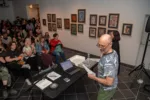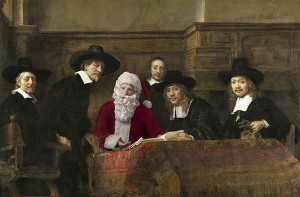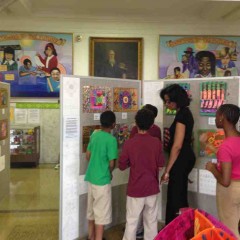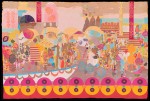This is the third year for the Cooke Museum of Art at Jay Cooke Elementary School.
Just off North Broad Street in the Logan section, the school’s Museum of Art is a project organized by Diane Pieri who also works with Cooke students as an artist in residence through the PMA’s Art Partners Program. Pieri works closely with the school’s art teacher to do the project. This year the school had a new art teacher, Young Kim, who worked with the artist and the students to get the Museum off the ground. Pieri got the idea for the museum project three years ago when Cooke’s principal, Mr. Gerald Branch, invited her to come up with an idea for an art project. He had some discretionary funds and he wanted to use them on a school-wide art project.
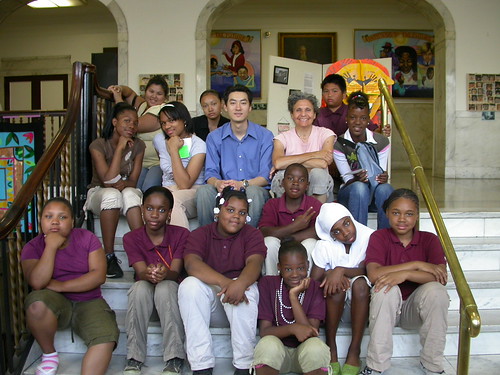
Student artists and teachers Diane Pieri and Young Kim posing at the Cooke Museum of Art, Cooke Elementary School.
Cooke is a school with a back story of underachieving students and low test scores. But in 1997 the school’s team of administrators and teachers took action and turned the place around. More here.
Principal Branch, himself an artist, has fostered a rich art program in the school that includes painting the lockers as wall murals and showcasing student art on the walls in the school’s corridors. Last year was my introduction to the Cooke Museum. I wrote about it for the Weekly (see post). This year, the Museum included three projects: photography (8th graders), mandalas (7th graders) and story flip books (4th graders).

Landscape photo by Jennifer Yoth. “The theme of my pictures is “City Life.” The pictures express the struggles of people living in the city. People that visit Philadelphia say that it’s a beautiful place. My project shows people that there is another different world in Philadelphia. My pictures show why city people go through rough times. But it also shows places that can cheer them up.”

Kassandra Pagan. “If I was a photographer, I would take pictures of my friends and family. I would even take pictures of pictures in the museum.”
The photographs, which line the walls of the main stairway to the school, chronicle the students’ journey through Philadelphia with a camera and a theme. Each student had to choose either portraiture or landscape for their theme and then take 27 photos with a disposable camera given to them. (All supplies and materials are paid for through Pieri’s grant from the school). The students then chose — with the help of Pieri — one work to appear in the Museum which was printed as an 8×10 print and framed. They all had to write statements about why they chose their topic. The students I spoke with all said that they didn’t own a camera.
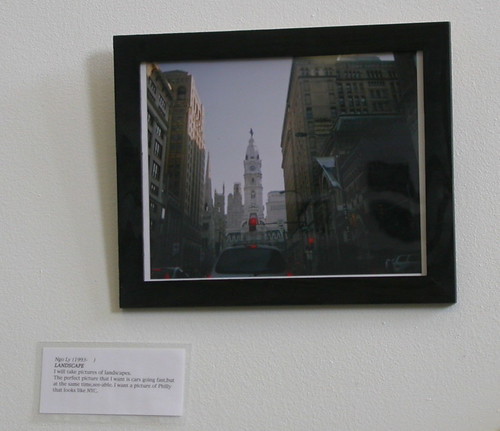
Landscape photo by Ngo Ly. Taken through a car window on North Broad St.
Pieri told me that photographer Judith Steinhauser came to talk with the students to give them a list of do’s and don’ts. One of the don’ts was don’t take a photo through a window. One student, if I understood her right, violated that don’t by snapping a picture of City Hall while riding in a car. She took the picture through the car’s windshield, a shot that was selected to be in the Museum. That was a great art lesson –sometimes you have to break the rules to get a good shot.
I was impressed with the photos and thought that photography and documentation were great projects for this day and for this age student. Also, the students I talked with did not own a camera, so it was real world introduction to art in many ways. Portraits were of friends and family–squarely in the snapshot aesthetic but very nicely done. But the landscapes — urban of course — got into politics as the students unabashedly documented down and out parts of their neighborhood in order to show what was in their view each day.
Mandalas
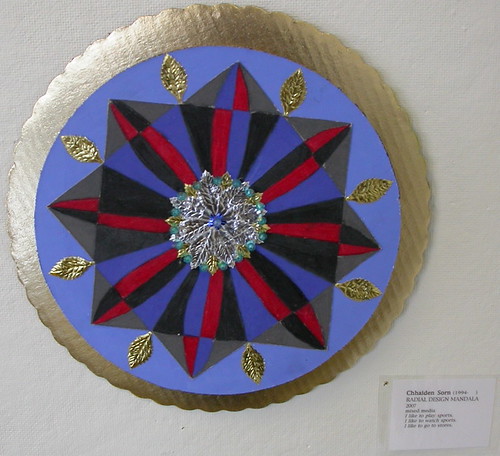
Chhalden Sorn, Radial Design mandala, mixed media. “I like to play sports. I like to watch sports. I like to go to stores.”
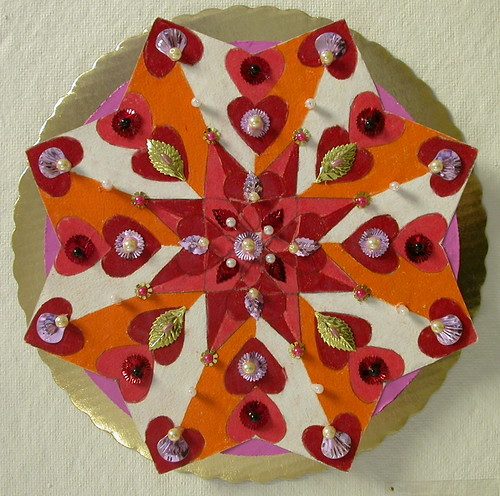
The 7th graders got in to the mixed media materials (nice Prismacolor color pencils, and beads and gold leaves from the craft store). They told me they had to do a sketch first before going to the final piece and that was a surprise for them. They seemed pleased with the results and there was surprising variety within the standard format of circle within square within circle.
Flip Books
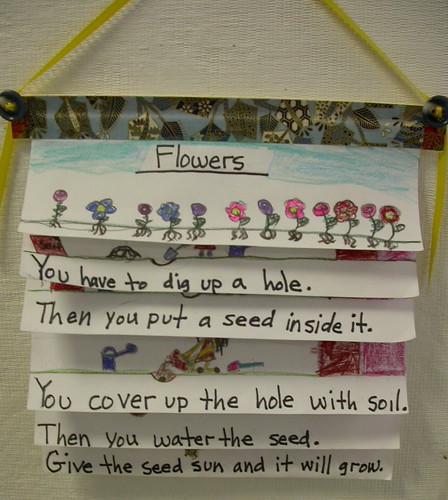
Angela Long, “Flowers”
Luna Flip book, mixed media.
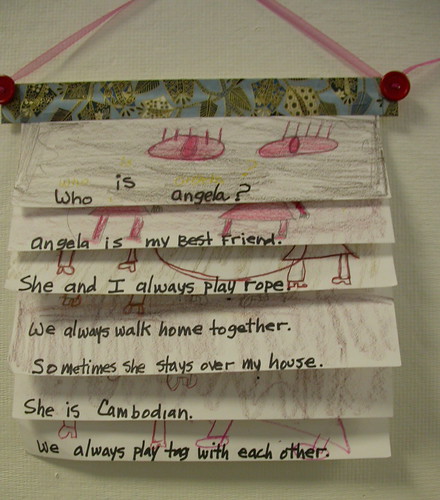
Keena Colt-Jones “Who is Angela?”
Luna Flip book, mixed media.
“I like to play rope. I like to stay up late. I like to make friends.”
The 4th grade flip books involved the students writing a short story as well as illustrating it, so the project involved a literacy component as well as art. Note: they were not animation-type flip books but their format was stacked and nested pages each of which you flipped up to read) Many of the books were about pets–imaginary or otherwise, or friends, or how to grow a flower. They were domestic in nature and the surprise to me in this project was to see the range of sophistication, both in words and drawings. Some of the students were clearly more advanced and some were less so, both in execution and in concept.
Next year, Cooke gets a new principal since Mr. Branch has been re-assigned to a new school. But Pieri told me that he assured her that the funds for the Cooke Museum of Art were in the school’s budget and that the Museum would continue. I do hope so since my two visits to the school have filled me with hope for art’s place in the curriculum. Hands-on projects like these, organized into a larger public-spirited show, give students the ability to work towards a goal and then be rewarded in a concrete way by seeing their work treated with dignity and placed where all can view it and talk about it.
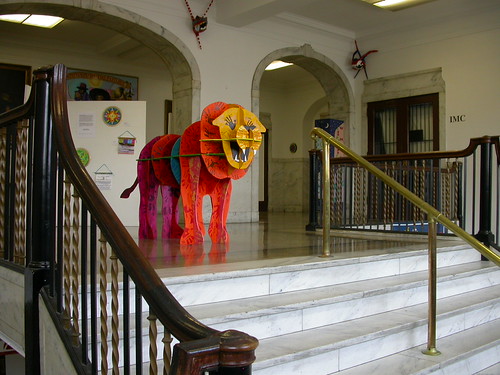
William Casey, art teacher last year at Cooke, turned the school’s mascot, a lion, into this colorful creature that sits now in the school’s lobby.
More photos at flickr.
We’ve been writing a lot about school art programs lately because several, like the Mural Arts Program’s in-school mural projects, are under threat having been cut out of the next year’s school budget. We are hopeful that private funders will step up and continue these programs which give alternate ways of learning and experiencing the world to students who otherwise might never get their hands on a brush or a camera and might not know they can express themselves that way. Also, these programs offer employment to artists and a kind of mentoring/role modeling opportunity for both artist and students. At a time when there’s no organized governmental support of artists and no organized leadership to say we need such support, it is crucial that these ancillary school art programs continue. Students rarely have the opportunity to work with artists and these in-school projects provide a needed window into a world different that what’s offered through the standard curriculum.


